There might not be any true freshwater shark species, but many tropical fish resemble their more fearsome marine counterparts. The freshwater aquarium hobby is home to many fish with a shark name. Each of these species has its own tank and care requirements, and most are kept in schools.
Some species are beginner-friendly, while others require close attention, pristine water conditions, and massive tank size. Keep reading to find out everything you need to know about freshwater sharks, the different species available, and how to care for them in your aquarium!
What are freshwater sharks?
A freshwater shark is a misnomer for a freshwater fish that looks like a marine shark. There are no actual sharks that live exclusively in freshwater, though bull sharks (Carcharhinus leucas) have been found living in brackish and freshwater tributaries for extended periods. Luckily, none of the freshwater sharks available in the aquarium hobby will get as massive or aggressive as a bull shark!
Instead, some of these fish display active, schooling behaviors that will fit nicely in a community tank setting, while others need more solitary conditions.
Freshwater shark tank mates
Despite having such a fearsome name, freshwater sharks can be kept with a large assortment of fish and invertebrates. Tank mate compatibility will entirely depend on the temperament of the species and the behavior of the individual fish.
In general, it’s safe to assume that most community tank freshwater sharks will be compatible with other peaceful fish, such as:
- Tetras
- Corydoras
- Rasboras
- Gouramis
- Livebearers
On the other hand, some freshwater shark species might do better with larger and more semi-aggressive tank mates, like:
- Barbs
- Rainbowfish
- Angelfish
- Cichlids
The best freshwater shark species for your aquarium
Freshwater sharks are some of the most active and impressive fish in the freshwater hobby: they’re fast, uniquely shaped, and look incredible moving in a school.
However, some of these fish can get pretty big and demanding, and not many aquarists can keep up with their long-term care requirements.
For example, Bala sharks (Balantiocheilos melanopterus) have become extremely popular over the past decade. Their large size, increasing cost, and slightly aggressive nature have led many hobbyists to unexpectedly rehome their fish once they got too big.
As long as tank size requirements are met, these fish don’t need much more than suitable aquarium water parameters and a proper tank setup.
Bala shark
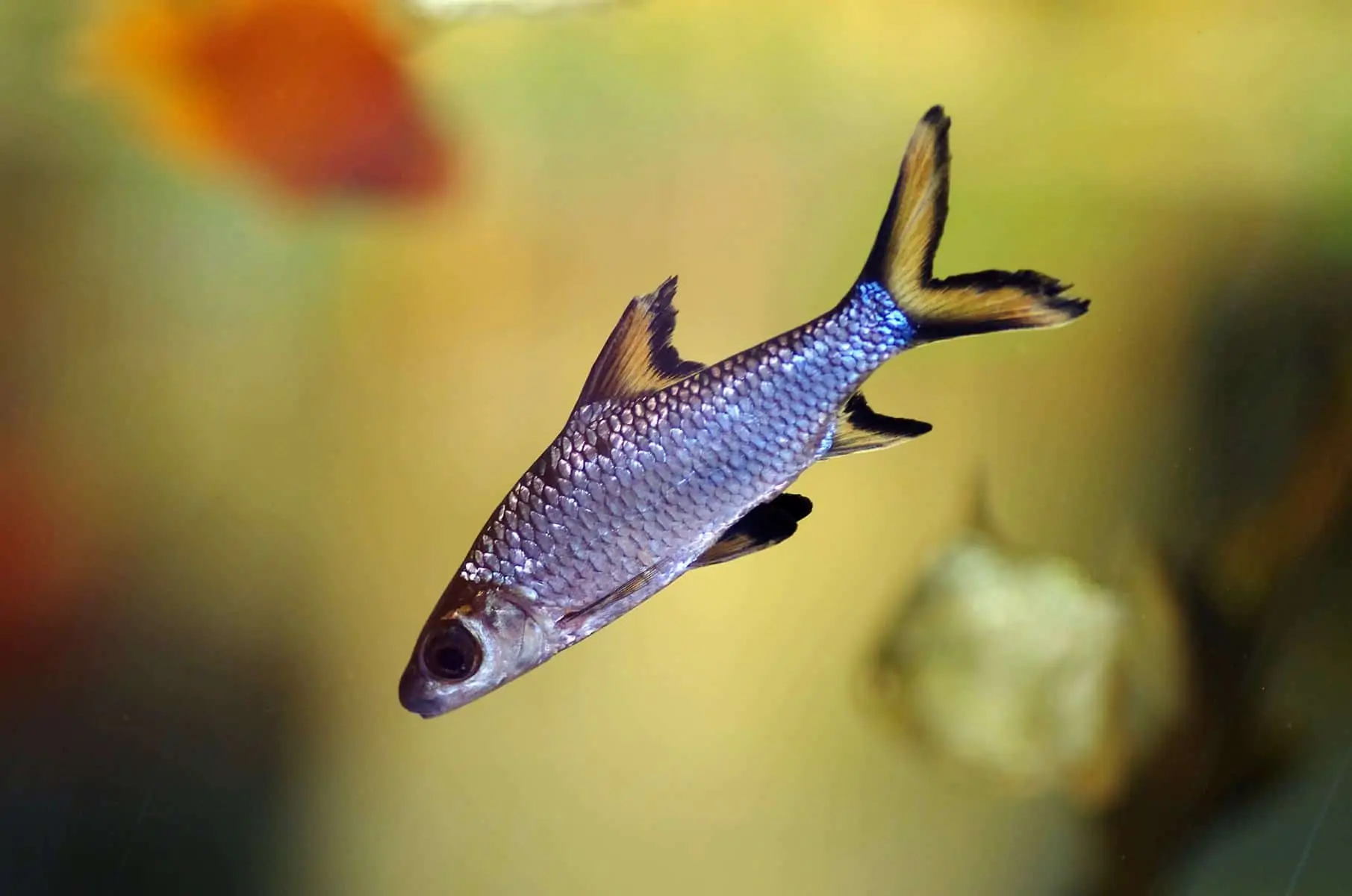
- Scientific name: Balantiocheilus melanopterus
- Origin: Indonesia, Sumatra, Borneo
- Mature size: 14 inches (35.6 cm)
- Minimum tank size: 125 gallons (568.26 L)
- Aggression level: Semi-aggressive
Also known as the silver shark, the Bala shark is one of the worst shark choices for beginners but one of the best additions for more experienced hobbyists, mainly due to their massive potential size and demanding tank size requirements.
In addition to a larger tank setup, this beautiful species appreciates high water flow, good oxygen circulation, stable aquarium water parameters, and plenty of open swimming space.
In the wild, Bala sharks are found in fast-moving rivers and streams, jetting along in open water to their next destination.
These popular freshwater aquarium sharks are very appealing in the aquarium. Bala sharks have a torpedo-shaped body and are colored iridescent silver with black color accents on their fins.
In a school of five or more, these active shoaling fish indeed look like they could pose a serious threat to other fish. Luckily, Bala sharks are only semi-aggressive. They can become aggressive towards each other if left in small groups where a hierarchy may form. They can also become aggressive towards similar-looking species.
Unfortunately, the Bala shark is listed as a vulnerable species on the IUCN Red List of Threatened Species as of 2019. Decreasing wild populations are mainly due to overfishing and habitat destruction.
Because of this, most, if not all, Bala sharks available in the aquarium hobby have been aquacultured at the commercial scale. Due to their adult size and somewhat demanding care requirements, they have not yet been bred at the hobbyist level.
The Bala shark can be found in almost every aquarium store, but few aquarists can care for these fish long-term. But if you have a large semi-aggressive tank, then the Bala shark could be a great addition!
Rainbow shark
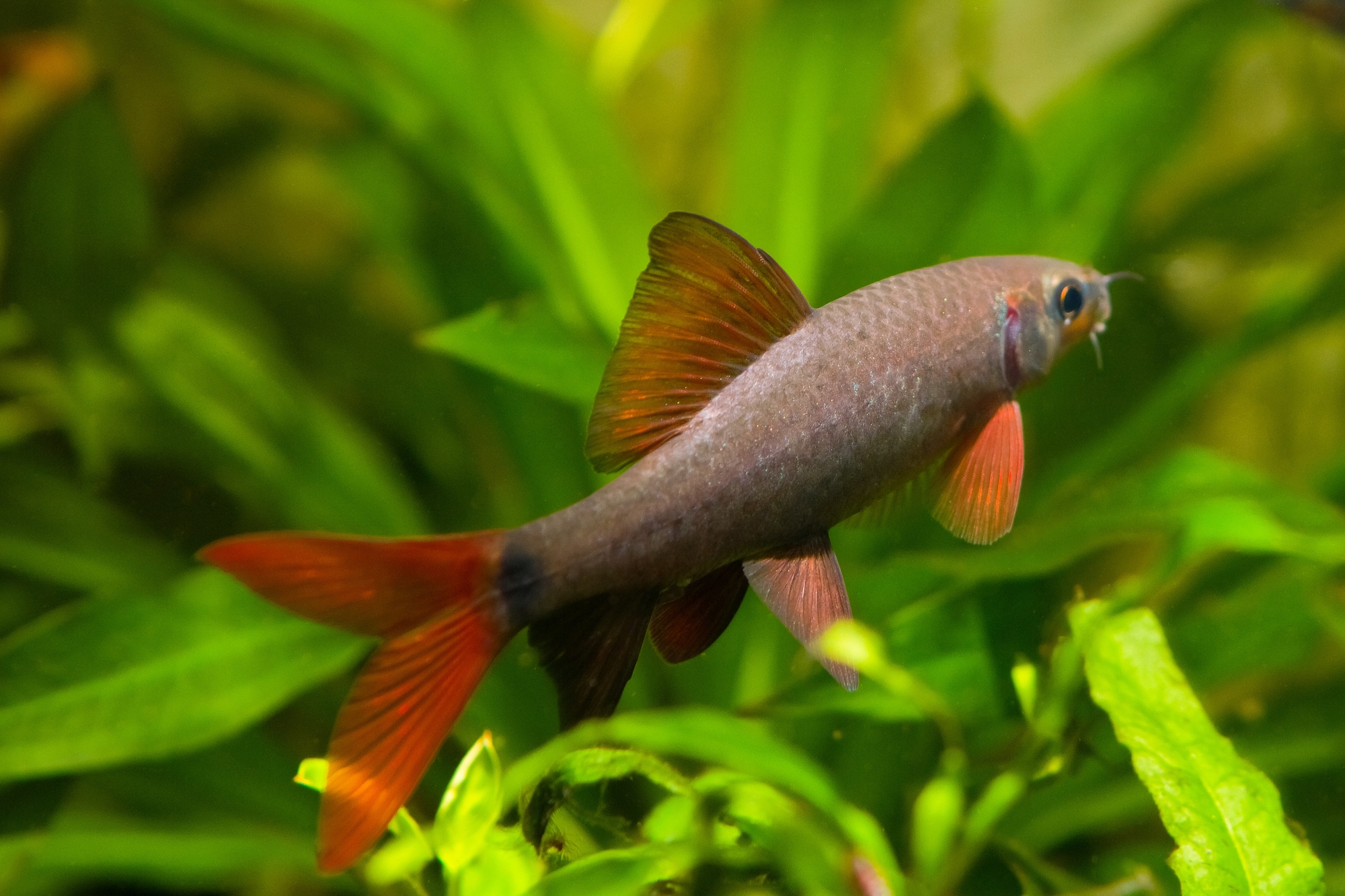
- Scientific name: Epalzeorhynchos frenatum
- Origin: Thailand, Laos, and Cambodia
- Mature size: 6 inches (15.2 cm)
- Minimum tank size: 55 gallons (208.2 L)
- Aggression level: Semi-aggressive
Another freshwater shark labeled as semi-aggressive, the Rainbow shark, can be successfully kept in community tank setups.
All other tank mates must swim toward the top of the water column to make this community work, as rainbow sharks spend most of their time at the bottom of the tank. As long as there is plenty of space between your sharks and other fish, there should be few problems with aggression.
Rainbow sharks are extremely aggressive toward their own kind and will attack other bottom-dwellers. They lead solitary lives and become increasingly aggressive as they grow. Adding plenty of aquarium plants for coverage can help minimize some aggression.
Though these fish are relatively easy to keep, they are not the best choice for beginner hobbyists. Believe it or not, Rainbow sharks can live to be 15 years old. Many hobbyists also aren’t aware of just how aggressive they can get.
The Rainbow shark can be light grey, dark blue, or near black; albino varieties of the Rainbow shark are also available. These fish have a downward-pointing snout to help them dig for aquarium algae and other detritus in the sandy substrate. They also have red-orange pectoral, dorsal, ventral, anal, and caudal fins.
Red-tailed Black shark
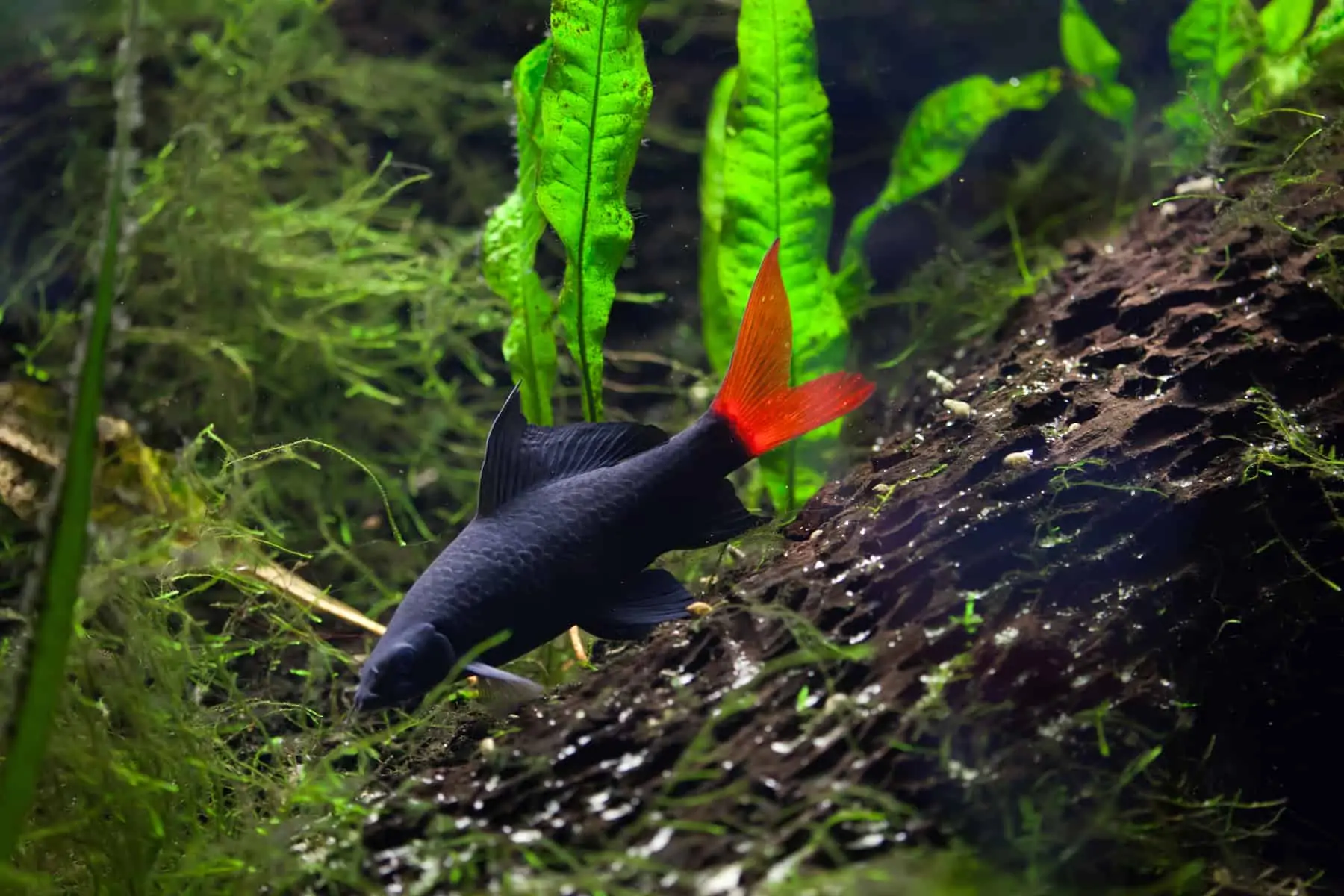
- Scientific name: Epalzeorhynchos bicolor
- Origin: Thailand
- Mature size: 6 inches (15.2 cm)
- Minimum tank size: 55 gallons (208.2 L)
- Aggression level: Semi-aggressive
The Red-tailed Black shark, also known as the Redtail shark, is another species of freshwater fish commonly found in local pet stores and sometimes misidentified as a Rainbow shark. However, these fish aren’t exactly beginner-friendly.
The Red-tailed Black shark is named for its bright red tail, midnight black body, and white snippet at the top of its dorsal fin. At first glance, they greatly resemble the Rainbow shark. And the care requirements for these two fish are the same. There are a few main differences between them, though.
First, Red-tailed Black sharks are slightly smaller, 4-6 inches in length (10.2-15.2 cm). A more significant difference is their aggression level. The Red-tailed Black shark is semi-aggressive. They can’t be kept with peaceful community fish, and overly aggressive fish will stress them out. They are especially aggressive toward each other and other similar-looking fish.
However, they can be kept with species like gouramis, angelfish, and larger tetras.
Even though the Red-tailed Black shark might look like an algae grazer with its downward-pointing mouth, these fish are primarily scavengers. They should not be used for algae control, especially since only one can be kept per tank, but they do enjoy a good algae wafer.
For a complete care guide on the Red-tailed Black shark, check out this article!
Iridescent shark
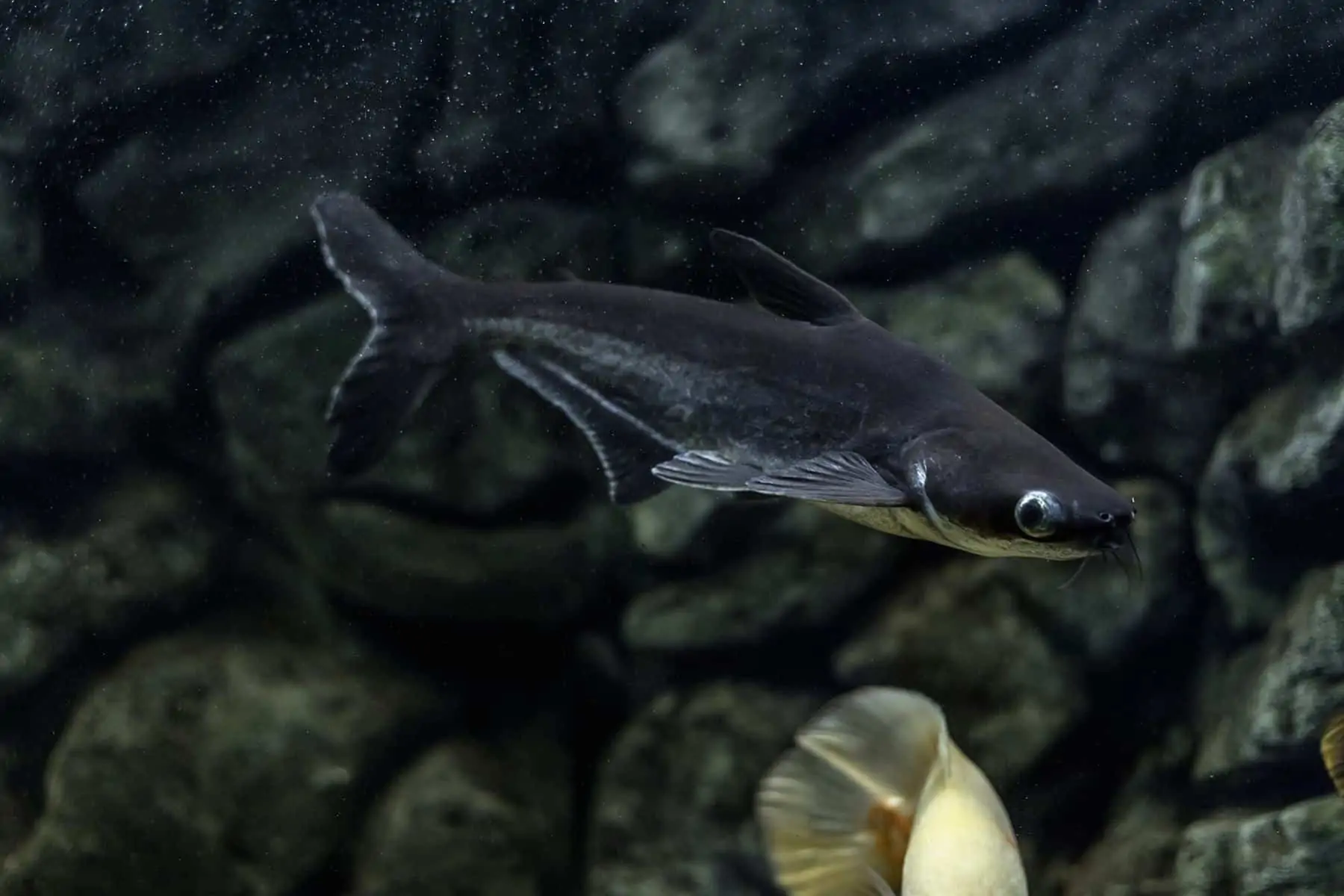
- Scientific name: Pangasionodon hypophthalmus
- Origin: Thailand, Cambodia, Laos, and Vietnam
- Mature size: >1.5 feet (45.7 cm)
- Minimum tank size: 300 gallons (1135.62 L)
- Aggression level: Semi-aggressive
Iridescent sharks are monster fish. They originate from large river systems throughout Southeast Asia, where they swim on the murky bottom, eating anything that happens to float by. These massive fish are scavengers that are constantly eating and growing. In the aquarium setting, this can cause problems for tank mate selections.
The Iridescent shark isn’t aggressive by nature; they’re actually very peaceful fish that could be kept with an assortment of other fish. However, they’re nocturnal with poor eyesight, making it difficult for them to tell food apart from other fish or objects.
In addition to their rapid growth and immense size, this makes the iridescent shark a problematic or impossible species to keep for most hobbyists. Even at their huge size, they’re still mini compared to their saltwater counterparts, but might do well in a heated outdoor pond.
You should also note that in 2011, Pangasionodon hypophthalmus was listed as an endangered species by the IUCN Red List of Threatened Species.
Roseline shark
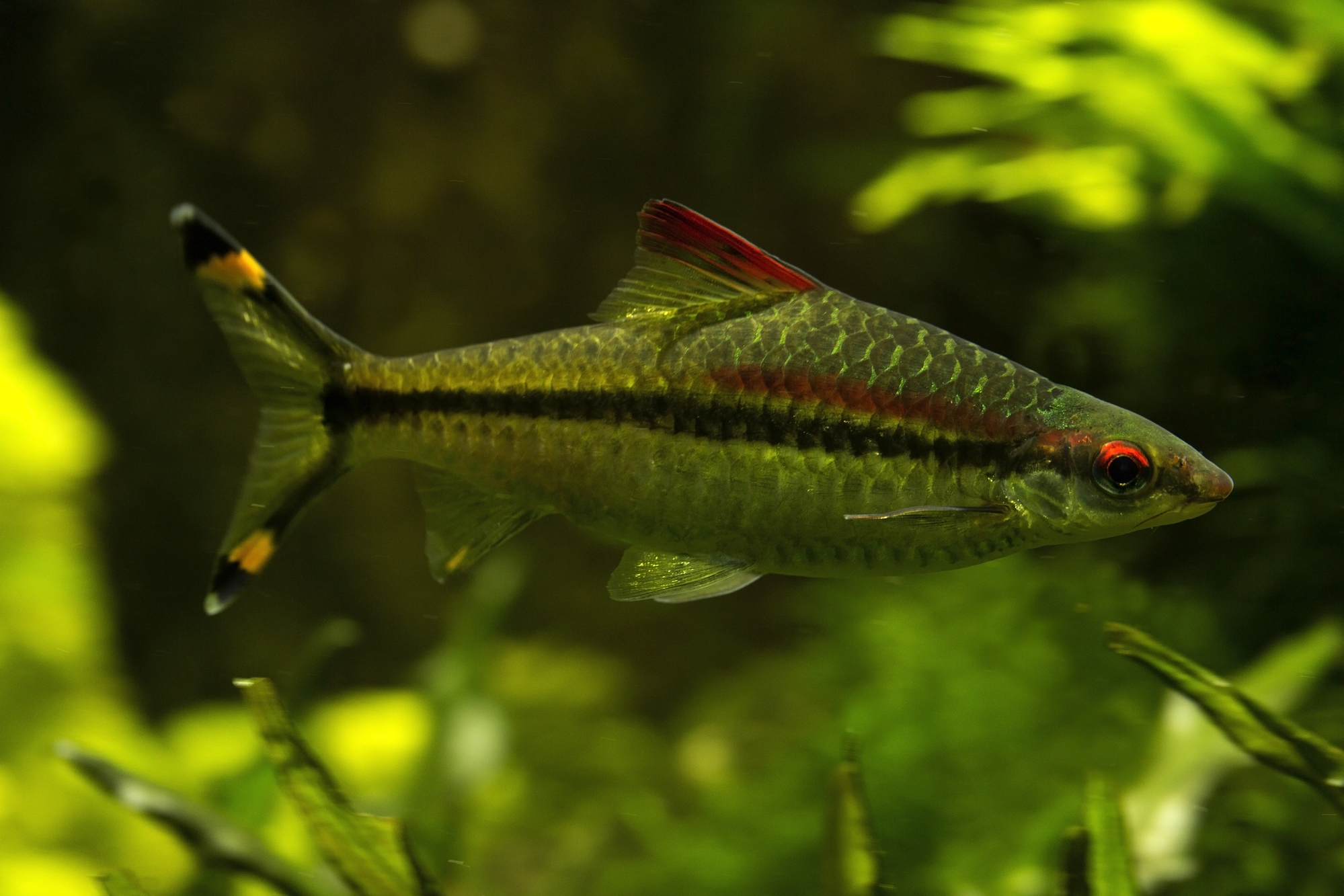
- Scientific name: Sahyadria denisonii
- Origin: Southern India
- Mature size: 5 inches (12.7 cm)
- Minimum tank size: 55 gallons (208.2 L)
- Aggression level: Peaceful
The Roseline shark, commonly known as the Denison barb or Red-lined Torpedo barb, is an extremely colorful and peaceful fish that can bring a lot of movement to the community aquarium.
These fish have a plain, yellowish-tan base color with red, yellow, and black streaks running across their body. They get their shark nickname due to their elongated, torpedo-shaped body that is much different from other related barbs.
Roseline sharks originate from fast-moving, highly oxygenated waters with dense plants. Their preference for near-pristine water conditions can make them more difficult to keep than other species, though they are relatively hardy if tank maintenance is maintained.
Interestingly, they tend to be more active at dawn and dusk than during peak daylight hours. Though most of these fish have been bred in the aquarium hobby and will likely be consistently active throughout the day, your fish may display this behavior.
The Roseline shark is a schooling species and needs to be kept in groups of at least six or more fish.
These fish are very similar in appearance to Sahyadria chalakkudiensis, though they are rarely available in the aquarium hobby.
Harlequin shark
- Scientific name: Labeo cyclorhynchus
- Origin: Congo River basin
- Mature size: 6 inches (15.2 cm)
- Minimum tank size: 55 gallons (208.2 L)
- Aggression level: Peaceful
A mix between a koi fish and a shark, the Harlequin shark is a very appealing orange and black speckled addition to the freshwater aquarium.
These fish are native to the Congo river basin in the Democratic Republic of the Congo and the Republic of the Congo. They live solitary lives under the forest canopy in vegetative areas with light tannins.
Harlequin sharks are interesting feeders. They are predominantly grazers, enjoying microscopic life living on the surfaces of leaves, rocks, and wood. They have been found living with the hippopotamus, feeding on dead skin and other biofilms growing on the animal.
In the aquarium, these fish get more aggressive as they age. They need plenty of hiding spots during the day.
Harlequin sharks can also be more expensive and harder to find than most tropical fish, so it’s important to give them a proper freshwater shark tank setup from the start for long-term success.
Colombian shark
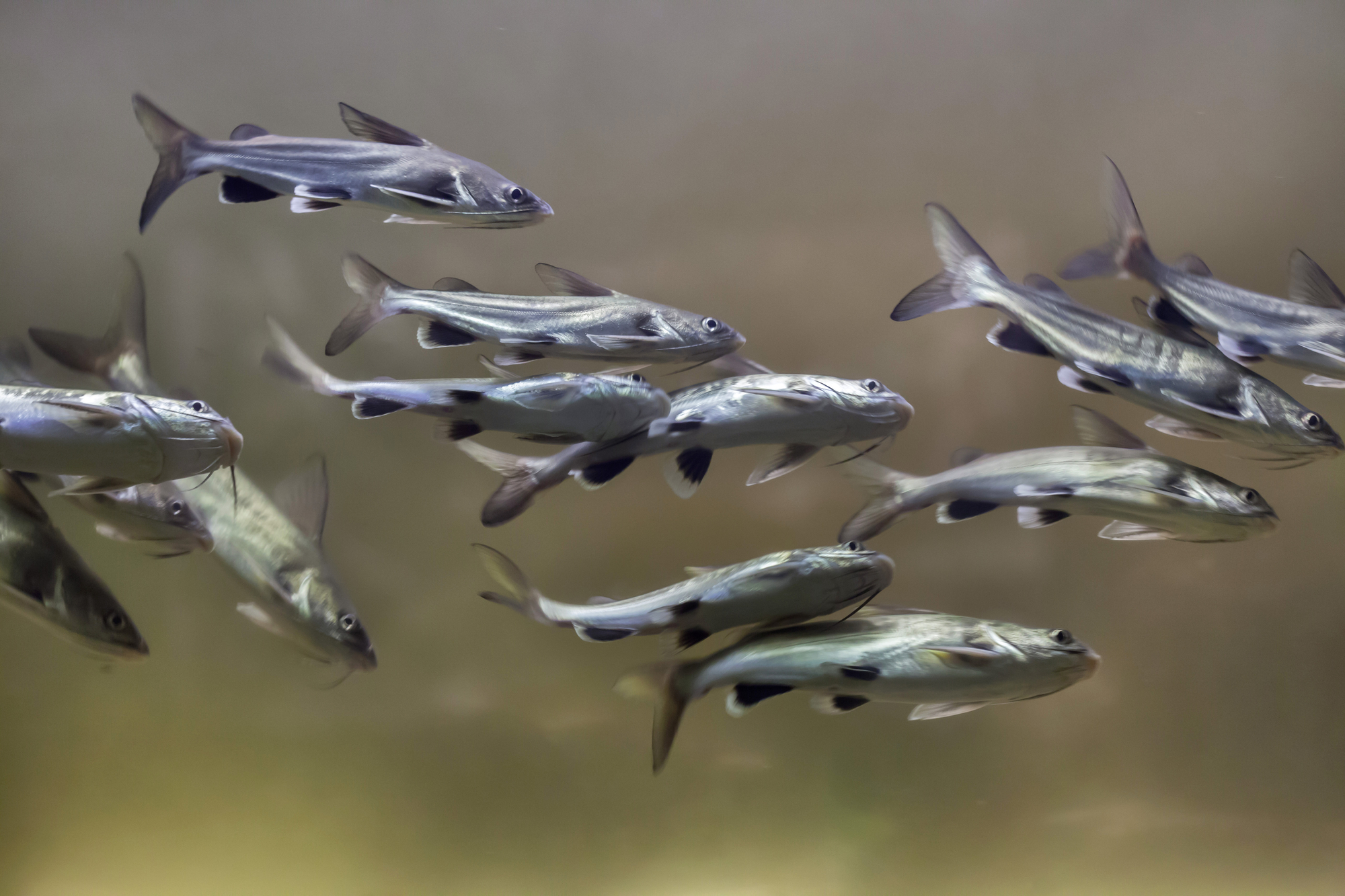
- Scientific name: Ariopsis seemanni
- Origin: Central America and South America
- Mature size: 10 inches (25.4 cm)
- Minimum tank size: 75 gallons (283.9 L)
- Aggression level: Peaceful
The Colombian shark, also known as the Hi-fin Bull shark, isn’t a true freshwater shark species but made this list due to its uncanny resemblance.
Instead, the Colombian shark is a species of brackish water fish. These predatory fish can be found in areas along the western coasts of Central and South America, where freshwater rivers and tributaries mix with the Pacific Ocean.
Unfortunately, there is a lot of misinformation about the Colombian shark in the aquarium hobby, and they’re mistakenly kept in purely freshwater conditions; it’s also erroneously called the Columbian shark.
Unlike the other species of catfish on this list, the Colombian shark stays manageable at adult size. They are also pretty peaceful and can be kept with a wide variety of other brackish water fish.
As a catfish, though, they’re still likely to try to eat other smaller, slow-moving fish that could make an easy meal.
Otherwise, the Colombian shark does not need an elaborate freshwater shark tank setup. They do best when given plenty of open swimming space and ask for little else.
Chinese High-fin Banded shark
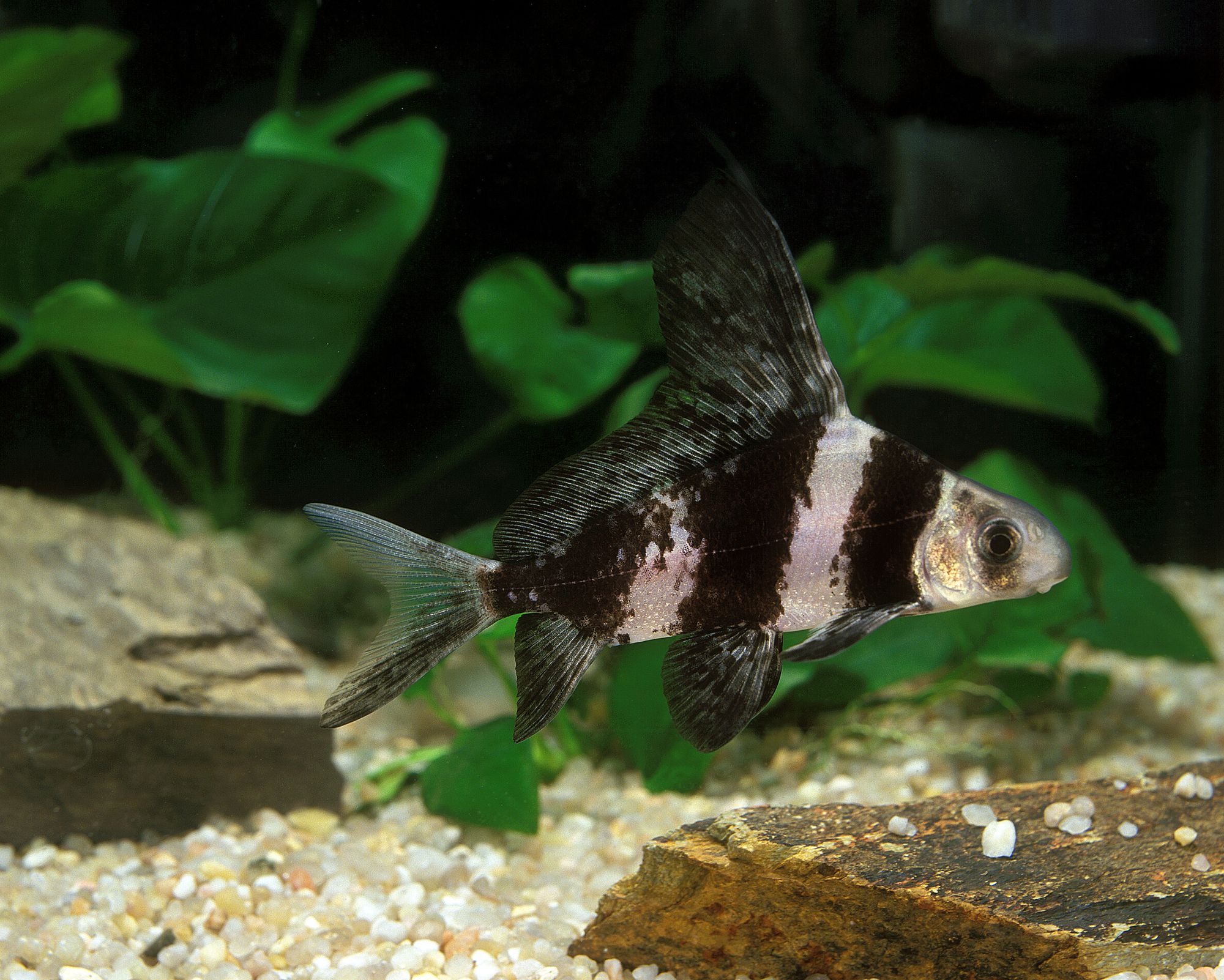
- Scientific name: Myxocyprinus asiaticus
- Origin: China
- Mature size: >3 feet (91.4 cm)
- Minimum tank size: 300 gallons (1135.6 L)
- Aggression level: Peaceful
The Chinese High-fin Banded shark, also known as the Chinese sucker due to its mouth structure, is a unique-looking fish that is only appropriate for very large aquarium displays.
These fish originate from very specific ecosystems within the Yangtze River system in China. They can be found in groups at the bottom of large rivers.
Chinese High-fin sharks can also be kept in groups in the aquarium setting with ample space. Otherwise, they are a largely peaceful fish species and pair well with other native river species.
The average hobbyist cannot keep Chinese High-fin Banded sharks. These fish can grow to be several feet long and weigh more than 80 pounds (36.3 kg). They also have an incredibly long lifespan, about 25 years on average.
You should also note that the Chinese High-fin Banded shark is banned from importation or ownership in several countries.
Red-finned Cigar shark
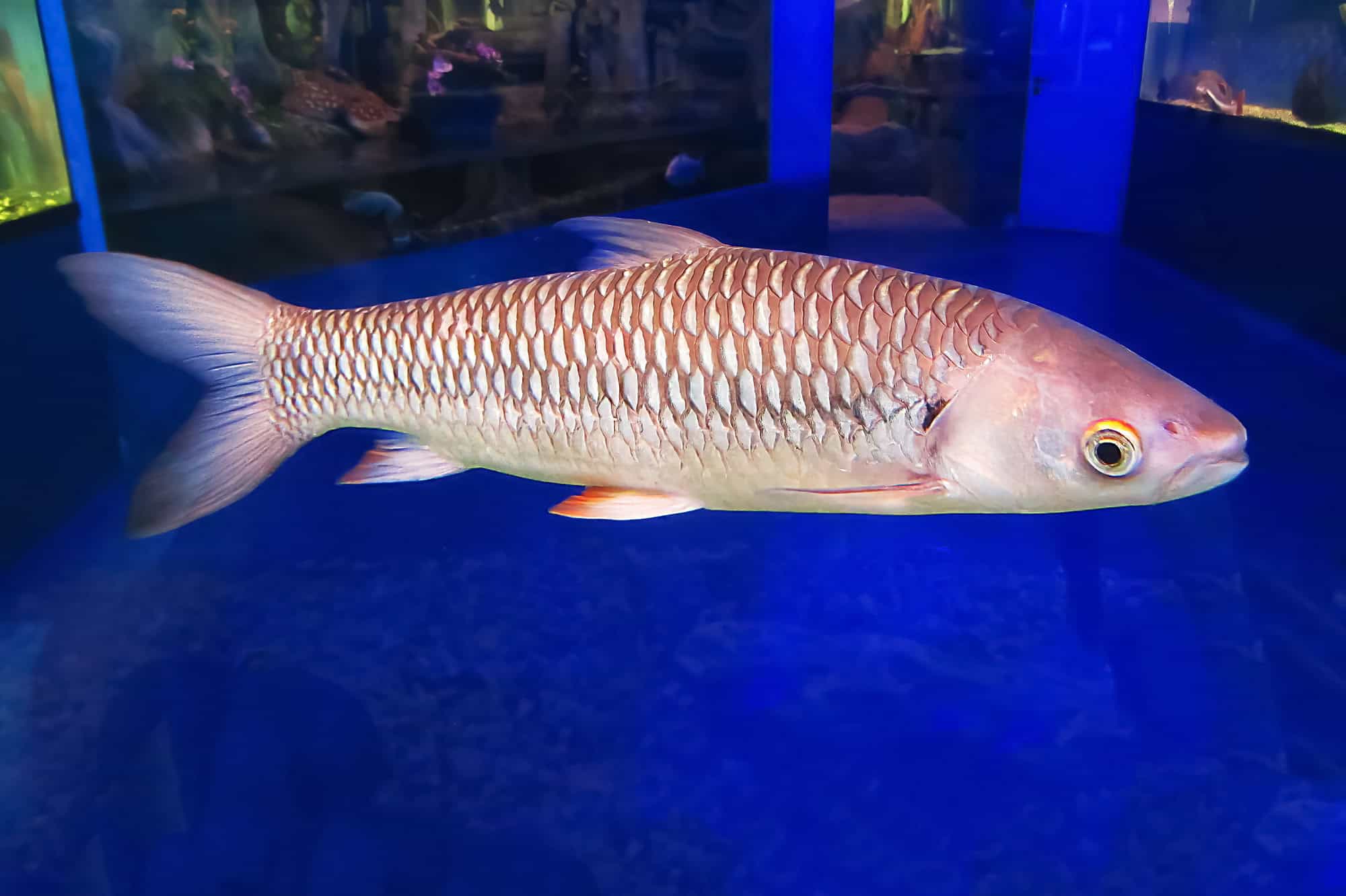
- Scientific name: Leptobarbus rubripinna
- Origin: Laos, Thailand, Cambodia, and Vietnam
- Mature size: >3 feet (91.4 cm)
- Minimum tank size: 300 gallons (1135.6 L)
- Aggression level: Peaceful
Also known as Hoven’s carp or the Mad barb, the Red-finned Cigar shark is a common fish in Southeast Asian countries but less popular as an aquarium fish due to its adult size. These silver fish are simple in appearance and might not seem like monster fish when they’re sold as juveniles only a couple of inches long.
Don’t be fooled, though. These fish can quickly surpass three feet in length and exceed 20 pounds (9.1 kg)!
These fish are typically found near the bottom of deep lakes and rivers, where they feed on plant matter and small invertebrates. They will also feed on smaller fish.
In the aquarium, Red-finned Cigar sharks are relatively peaceful and can be kept with other fish, though the average aquarist cannot keep these fish long-term.
Silver Apollo shark
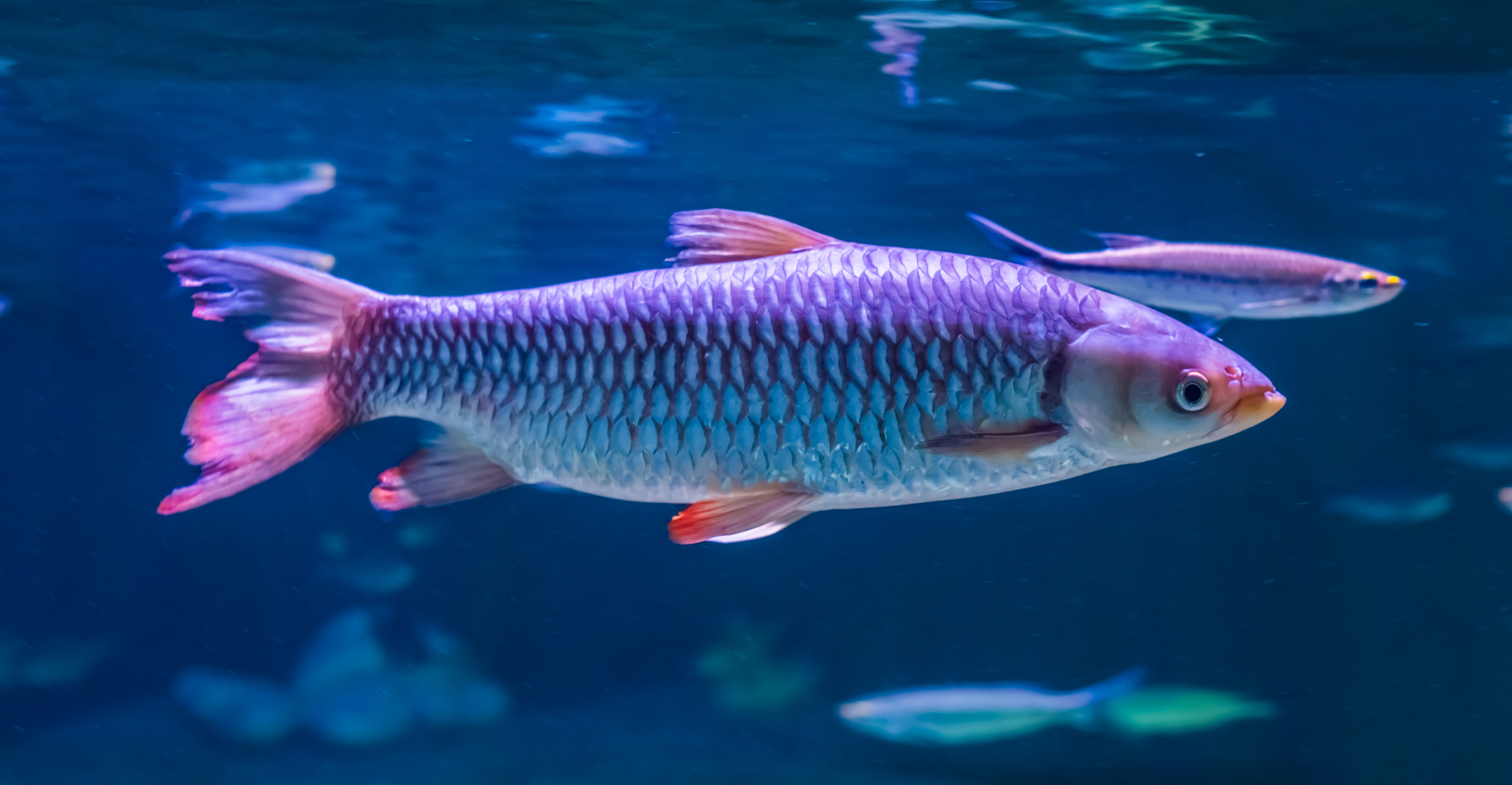
- Scientific name: Luciosoma setigerum
- Origin: Southeast Asia
- Mature size: 8 inches (20.3 cm)
- Minimum tank size: 125 gallons (568.3 L)
- Aggression level: Peaceful
A much more uncommon fish in the freshwater aquarium hobby, the Silver Apollo shark, is a very long and skinny metallic-colored fish.
This aquarium shark species should not be confused with the closely related–though strangers to the aquarium hobby–Long-finned Apollo shark (Luciosoma spilopleura) or Luciosoma pellegrinii.
Silver Apollo sharks are different from other freshwater aquarium sharks. They prefer the upper regions of the aquarium water column, where they can easily catch insects; most other species on this list live their lives on the bottom of the substrate.
These active fish are found in schools hunting for food in slow-moving, swampy waters. They will especially enjoy a leaf litter substrate in the aquarium to replicate their natural environments.
Unfortunately, little else is known about this species, and they’re not commonly found for sale.
What do freshwater sharks eat?
Actual sharks get their ferocious image from horror films and tragic headlines. Luckily, freshwater aquarium sharks are only threats to algae, microinvertebrates, and sometimes smaller fish. Don’t be afraid to put your hand inside your fish tank with one of the species on this list!
Most freshwater aquarium sharks are omnivores. They’ll eat both plant- and animal-based foods. The species on this list can be given a healthy variety of live, freeze-dried, and frozen meaty foods, such as brine shrimp and bloodworms. A high-quality fish flake or shrimp pellet may be given as the staple food of a balanced diet.
Bottomfeeders will especially enjoy sinking pellets that make feeding easier. Algae-eating species may also be given an algae flake or pellets in addition to blanched vegetables.
The larger, more carnivorous fish species on this list will enjoy a special treat of frozen foods, like clams, scallops, or raw shrimp.
Are there any true freshwater shark species?
None of the species on this list are true sharks, meaning that none of them belong to the superorder Selachimorpha. But, are there any Selachimorpha members that can live in freshwater conditions?
Yes, there are. However, they cannot live in fresh water forever.
One of the most notable species of saltwater shark that can live in freshwater conditions for a considerable amount of time is the Bull shark (Carcharhinus leucas).
Bull sharks have been found living in different salinities for varying periods of time. It’s believed that Bull sharks could live in fresh water their entire lives if they didn’t rely on coastal regions with mixed salinities for reproduction.
Very few other species have such an ability to regulate how salt and water move throughout their systems, making the Bull shark one of the most adaptable sharks.
Conclusion
The species of freshwater sharks on this list are not actually real sharks, though their foreboding silhouettes could fool some. Instead, many of the fish on this list are easy to keep, though some require an enormous minimum tank size.
Freshwater sharks can live a long time given proper tank and water conditions. They are also some of the entertaining fish species to feed in the entire hobby.
If you have any questions about freshwater sharks, other types of saltwater sharks, or if you have had experience keeping a monster fish in your aquarium, don’t hesitate to leave a comment below!












